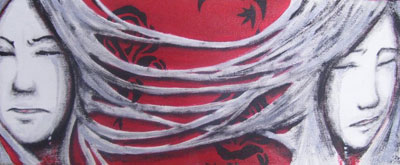All Nonfiction
- Bullying
- Books
- Academic
- Author Interviews
- Celebrity interviews
- College Articles
- College Essays
- Educator of the Year
- Heroes
- Interviews
- Memoir
- Personal Experience
- Sports
- Travel & Culture
All Opinions
- Bullying
- Current Events / Politics
- Discrimination
- Drugs / Alcohol / Smoking
- Entertainment / Celebrities
- Environment
- Love / Relationships
- Movies / Music / TV
- Pop Culture / Trends
- School / College
- Social Issues / Civics
- Spirituality / Religion
- Sports / Hobbies
All Hot Topics
- Bullying
- Community Service
- Environment
- Health
- Letters to the Editor
- Pride & Prejudice
- What Matters
- Back
Summer Guide
- Program Links
- Program Reviews
- Back
College Guide
- College Links
- College Reviews
- College Essays
- College Articles
- Back
Science of Burning Hair
Today, I burned my hair. Twice. For the same reason. And it was not because I was trying to straighten my hair. On the contrary, I knelt over the stove to smell a delicious meal, when I leaned a bit TOO much.
My hair, slung in a ponytail, rushed into the sizzling fire. I gasped as a smell that can only be described as horrendous filled the room. I saw that my once nearly black hair now had streaks of light brown, and slightly curled hair near the bottom.
I ran my hand through them, desperately trying to rid my skull of the nine or ten unwanted brown stripes. They fell out onto the floor, and I gave a little shudder. I took a whiff of my hair again, and it was absolutely dreadful. The only way that it can be imagined is by burnt cow dung.
Basically, I burned my hair on the stove, little two inch pieces of my hair fell out and everything smelled simply horrifying.
I was mainly talking to myself when I said, “Disgusting! Who burns their hair on the stove?”
My mom laughed, and said, “You. The same one who gets sent home from school for burning their hands on the stove in cooking class.”
I rolled my eyes and walked away, thinking about the science behind burning hair.
A search gave me information about hair stylists who burn hair on purpose. Apparently, it seals off split ends and causes hair to grow faster. Victoria’s Secret models use it to keep their hair healthy. Well, they don’t do it an accident over a stove, like I did. The process is called Velaterapia, and Brazilian proponents claim that heat from the candle opens the hair shaft, making it more reactive to conditioning.
Dermatologists that specialize in hair say differently. The best way to treat split ends is to get regular haircuts,” says Dr. Melissa Piliang from the Cleveland Clinic. “Even small trims, called dusting, every six to eight weeks can make hair grow longer, stay healthier and fuller. It’s a much better option than putting fire near your hair, which is flammable, and seems dangerous.”
The final say is not to use Velaterapia, and that burning your hair isn't healthy either.

Similar Articles
JOIN THE DISCUSSION
This article has 0 comments.

I was inspired to write this piece because I burned my hair over the stove twice.